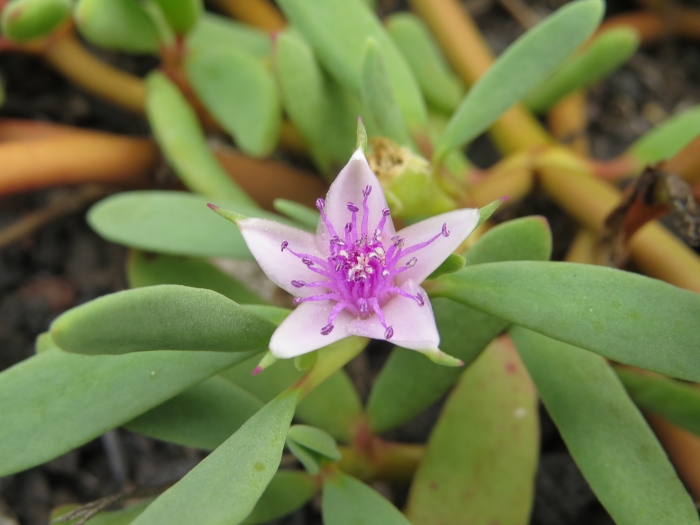Shoreline Purslane
(Sesuvium portulacastrum)
Shoreline Purslane (Sesuvium portulacastrum)
/
/

Leonel Roget
CC BY 4.0
Image By:
Leonel Roget
Recorded By:
Copyright:
CC BY 4.0
Copyright Notice:
Photo by: Leonel Roget | License Type: CC BY 4.0 | License URL: http://creativecommons.org/licenses/by/4.0/ | Rights Holder: Leonel Roget | Publisher: iNaturalist | Date Created: 2018-11-10T18:22:15-08:00 |

















































Estimated Native Range
Summary
Sesuvium portulacastrum, commonly known as Shoreline Purslane, is an evergreen perennial herb that is not native to forests but rather to coastal areas, including beaches, salt flats, and mangroves across the global tropics and subtropics. It typically sprawls close to the ground, reaching heights of up to 30 centimeters (12 inches) with thick, smooth stems that can extend up to 1 meter (3.3 feet) long. The leaves are smooth, fleshy, and glossy green, with a linear or lanceolate shape, ranging from 10–70 millimeters (0.39–2.76 inches) in length and 2–15 millimeters (0.079–0.591 inches) wide. The plant produces small pink or purple flowers throughout the year, which are particularly showy in warm climates.
Shoreline Purslane is valued for its salt tolerance and is often used in coastal landscaping, erosion control, and as a ground cover in saline environments. It is also used in green roofs and xeriscaping due to its low water requirements. The plant thrives in full sun to partial shade and prefers well-drained soils. While it is drought-tolerant, it can also survive temporary flooding and is thus suitable for rain gardens. Gardeners should be cautious, as Sesuvium portulacastrum can be potentially invasive outside its native range, especially in similar coastal habitats.CC BY-SA 4.0
Shoreline Purslane is valued for its salt tolerance and is often used in coastal landscaping, erosion control, and as a ground cover in saline environments. It is also used in green roofs and xeriscaping due to its low water requirements. The plant thrives in full sun to partial shade and prefers well-drained soils. While it is drought-tolerant, it can also survive temporary flooding and is thus suitable for rain gardens. Gardeners should be cautious, as Sesuvium portulacastrum can be potentially invasive outside its native range, especially in similar coastal habitats.CC BY-SA 4.0
Plant Description
- Plant Type:
- Height: 0.7-1 feet
- Width: 3-6 feet
- Growth Rate: Moderate
- Flower Color: Green, Pink, Purple
- Flowering Season: Summer
- Leaf Retention: Evergreen
Growth Requirements
- Sun: Full Sun
- Water: Medium
- Drainage: Fast, Medium, Slow
Common Uses
Erosion Control, Groundcover, Low Maintenance, Salt Tolerant, Street Planting
Natural Habitat
Coastal areas, including beaches, salt flats, and mangroves
Other Names
Common Names: Shoreline Seapurslane , Cencilla , ミルスベリヒユ , Beremi Laut , 海馬齒 , Sea-Purslane
Scientific Names: Sesuvium portulacastrum , Trianthema portulacastrum var. hillebrandii , Sesuvium portulacastrum var. subsessile , Polycarpon uniflorum , Sesuvium microphylium , Sesuvium uvifolium
GBIF Accepted Name: Sesuvium portulacastrum (L.) L.